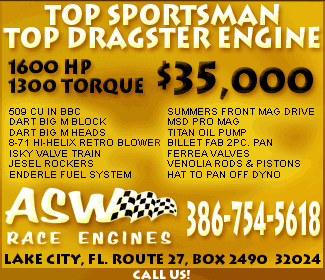|

QUESTION 1
Scott,
I have a 396 c.i. Chevy, .060 over, 9.0 to 1 with Edelbrock oval port RPM 110cc head with airgap intake and a Race Demon 825 cfm carb. The cam is 110 lobe overlap with 580/600 life and 256/266 at .050. With this the cranking compression is only 130 psi and good for 11.80 at 118 mph on the quarter-mile. I'm driving a '68 Camaro weighing 3,400 lbs. And am running a TH-350, 4:10 and 29-inch slicks.
If I advance the cam by 4 degrees, will it bring the cranking compression by much? Say 20 psi? Or should I change the cam for something like 112 lobe and 226/234 duration and 587/610 lift roller cam?
Thanks.
Luc LaFontaine
Luc,
Advancing the cam 2 to 4 degrees will increase
your cranking compression and add bottom end
power. Keep in mind that advancing the cam decreases
intake valve clearance.
You may want to consider increasing your
static compression from 9.0 to 1 for more performance
gain.
Scott
QUESTION 2
Scott,
How much open lift spring pressure can I run
without getting into collapse and wear issues
on hydraulic roller lifters? I'm going to install
a fairly radical hydraulic roller grind and
want to spin it up to 6500 without chancing
valve float or bounce.
ADVERTISEMENT
 |
|
I
found a spring that is 150 lbs at the seat at
installed height and 375 lbs at max lift. Is this
too much pressure for the lifter? I would rather
have slightly more spring than I need, for insurance.
Plus, the springs are bound to lose some tension
after some running.
Trey
Trey,
Hydraulic roller lifters tend to like more
spring psi on the seat and at max lift. This
is because the cam is ground with a quicker
or steeper ramp due to the use of the roller
follower, thus more performance. More spring
psi is required to keep the follower on the
lobe, eliminating bounce. The spring that you
mentioned will work just fine.
Scott
<
MORE STORIES >
|